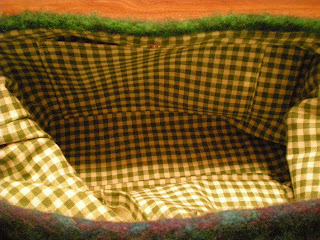Here we are again, back at looking at lining felted bags. This time, I will show some pictures of a flat bottomed bag that has a magnetic closure.

This is a very simple rectangular bag made out of Noro Kuyreon. The Kuyreon does all the striping work for me, and I love the colors. Noro is tough to felt, but if you have patience, it will create a lovely felted fabric. I didn't go with any embelishment on this bag, except the black leather fobs and silver rings which attach the hand-tooled and custom dyed leather handle. The fobs are sewn to the felted bag before I start the lining. I took this picture with the snap open so that I could show where I position the magnetic snap.

Here we are, looking inside the bag. This is drapery fabric which is much heavier than basic cotton gingham. I love the country look of gingham. Notice how the light color makes it easy to see inside the bag. This lining has two large pockets and a flat reinforced bottom. Let's turn it inside out and give the lining a better look.
Because this bag has a flat bottom, it stands up easily. Here we can see the magnetic snap and the size of the pockets. Notice again how I hide my stitches at the top of the lining by using a blind stitch.

I've laid the bag down so you can see the corners on the bottom of the lining. This bag bottom is reinforced with plastic canvas cut to fit and sewn to the felt bag bottom. It gives more support than interfacing. The plastic canvas is sandwiched between the felt and the lining fabric.

This is a close up of the square corner. It is made by folding the corner of the lining and sewing a diagonal which matches the width of the bottom. I trim away the extra triangle of fabric to reduce bulk in the corner. This also shows the tiny stitches I take to fasten the bottom of the lining to keep it securely in place while the bag is being used.
I hope you have enjoyed this little two part tutorial of how I add lining to finish my felted bags!